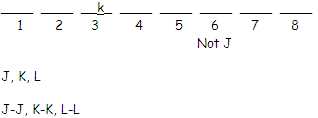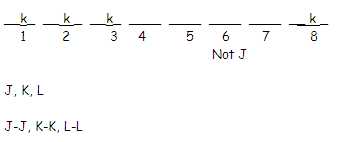Sequencing Game 3 Explanations
If you haven’t taken the time to try the LSAT Practice Sequencing Game 3 on your own before reading these explanations, please click back there and give it a try first. These are the explanations for the third sequencing game in a series of lesson articles about LSAT sequencing games. The series includes:
- LSAT Sequencing Games: an Introduction
- Sequencing Game Questions
- LSAT Practice Sequencing Game 1
- LSAT Practice Sequencing Game 2
- LSAT Practice Sequencing Game 3
You know this is sequencing and not matching or grouping because you are limited to one salesperson per day and those days go in order. You’re putting salespeople on a calendar, a common sequencing task.
To sketch this, first start with the eight days and your list of sales people:

That’s about all you can do until you get to the rules.
Rules and Deductions
The first rule states that each rep will at least attend on two consecutive days. That doesn’t mean they won’t attend on more days, consecutive or otherwise, but you know you’ll need to have each one attend at least two consecutive days. You might summarize this rule in the following way:
J-J, K-K, L-L
Taking a look at the sketch, you’ll note that after you fit in these three pairs, you’ll only have a couple floater days to work with.
The second rule keeps J off the sixth day, so write that into your sketch.
The third rule puts K on the third day. Add that to your sketch but not that it doesn’t mean the K-K pair has to go there, We have two floater days as well.
Your sketch should now look like:

Keep an eye on the J-J pair and the sixth day rule about J, these will present you some constraints to work with.
Question Explanations
We start with a basic question that pays off for thinking about the pairs of consecutive days.
7. What is the maximum number of days any single salesperson can attend the trade show?
(A) two
(B) three
(C) four
(D) five
(E) six
The salespeople have to have a minimum of two consecutive days which takes up six days and leaves us with two floater days. So the maximum number of days a sales person could go is four days or (C).
Next we get a hypothetical to plug into our sketch:
8. If Jordan does not attend on the first, second, third or fourth day, which one of the following must be true?
(A) Larson will attend on the second day.
(B) Kilpatrick will attend on the sixth day.
(C) Jordan will attend on the seventh day.
(D) Jordan will attend on the fifth day.
(E) Larson will attend on the fourth day.
Since Jordan has to have at least two consecutive days and cannot be on the sixth day, Jordan has to go on days 7 and 8. So (C) is correct. The other answers are all possible, but do not have to be true.
This is a tricky question. You plug in the hypothetical and then try to see how many different variations are possible. The LSAT could always throw you a curve, but typically in this type of question there won’t be too many variations. If you’re stuck and have to guess, you’re better off guessing low than high.
9. If Kilpatrick attends on the first, second and eighth day, how many different schedules of attendees are possible?
(A) one
(B) two
(C) three
(D) four
(E) five
Plug K into 1, 2 and 8 (remembering K always goes day 3) and you’re sketch looks like:

The J-J pair must go in 4 and 5 because it cannot go 6 and 7. That leaves 6 and 7 for L-L. That means that if the hypothetical is true, there can only be one possible schedule.:

Answer (A) is correct.
Another hypothetical comes next.
10. If Kilpatrick only attends two days, which one of the following must be true?
(A) Jordan attends on the first day.
(B) Jordan attends on the eighth day.
(C) Larson attends on the fourth day.
(D) Kilpatrick attends on the seventh day.
(E) Larson attends on the sixth day.
The deductions follow this way: K has to be on day 3, therefore can only be on either day 2 or 4. That means L has to go on day 6 because J is ruled out. So (E) is correct. If you had trouble making that deduction, you could rule out answer choices by trying to make them false. For example, (A) has J on the first day, so try making a sketch with L on the first day instead. That’s possible, so (A) must not be the “must-be-true” answer.
The next question continues our focus on where can we fit the consecutive day pairs.
11. If Kilpatrick attends on the fifth day, which one of the following CANNOT be true?
(A) Larson attends on the second day.
(B) Jordan attends on the seventh day.
(C) Larson attends on the eight day.
(D) Jordan attends on the first day.
(E) Kilpatrick attends on the seventh day.
If K is on the fifth day, that only leaves two possible day pairs open for Jordan (because of the no Jordan on day six rule): 1 and 2 or 7 and 8. So (E) is impossible and therefore the right answer. If K is on the seventh day there is only one two-day space left open, days 1 and 2; however, you still have the J-J pair and the L-L pair to place. The rest of the answers could be true.
The next hypothetical gives us a nearly complete sketch.
12. If Kilpatrick attends on the second and fourth days, all of the following must be true except?
(A) Larson attends on day five.
(B) Jordan attends on the first day.
(C) Jordan attends on day seven.
(D) Jordan is the last to attend the trade show.
(E) Larson attends day six.
If K is on days 2, 3 and 4, that only leaves 7 and 8 for the J pair which only leaves 5 and 6 for the L pair. Day 1 is a floater for anyone to attend. Since the right answer is a could be true or a must-be false, scanning for an answer choice regarding the first day will get you to the right answer faster. (B) is correct because it doesn’t have to be true, anyone can attend the first day.
Now return to our LSAT lab to read another lesson series.
Comments are closed.

[…] Sequencing Game 3 Explanations […]
Question 11: I realize you need a ‘J’ pair in 1-2 or 7-8, but why can’t another J go it 5?
Something like…
J-J-K-K-J-L-L-L
I don’t see why J can’t be on 5 – what am I missing?
Thanks!
Phil, great catch. I went back to our handouts for the TestSherpa class that this entry was based on and the question was typed in wrong here on the site. It’s been fixed to the original from the class and should make sense now.